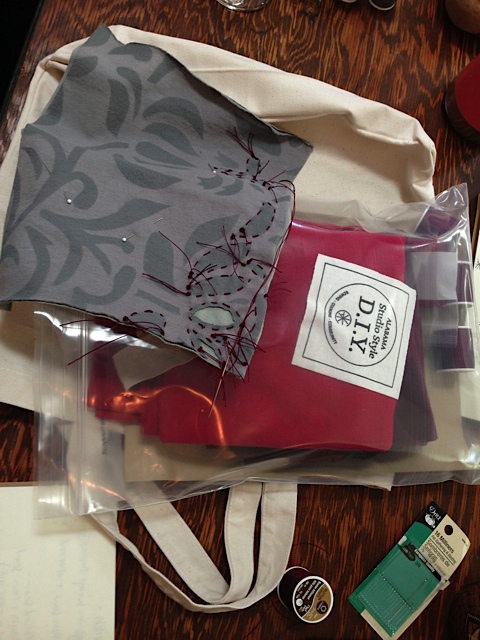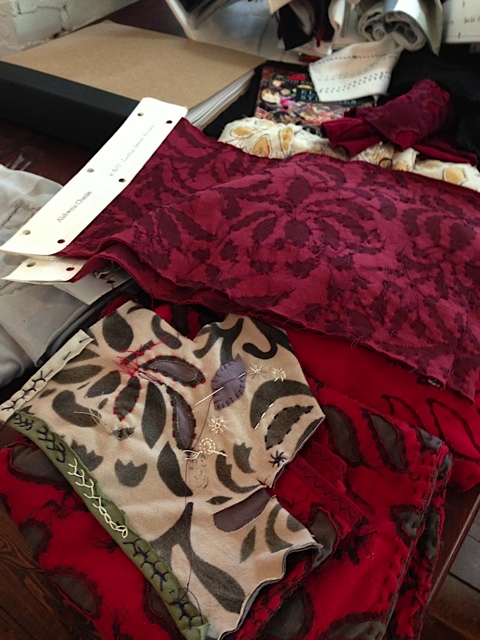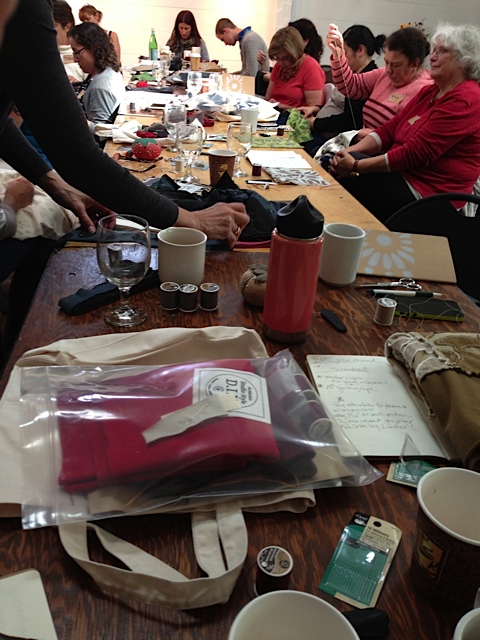back-to-school
It is back-to-school season, and off I traveled to Woodstock, NY for a one-day workshop with Natalie Chanin. Even though Natalie’s three books generously give one the needed information to make her garments, it was daunting to me to make a piece of clothing from scratch. Now, after a day spent receiving instructions from the Alabama Chanin team – Natalie and Oliva – as well as the exchange of information from fellow stitchers, I am confident that I can move forward with constructing the four-panel skirt.
We sat around a long table in a beautifully renovated barn structure, listened, stitched, and scribed notes. Natalie talked of quilters and artisans that have sewn clothing for hundreds of years. My grandmother taught me both to embroider and to sew by machine. Regrettably, I let these skills go by the wayside and am now working to regain them.

my Alabama Chanin DIY kit with all needed tools
Had I been born in 1738 like Rebecca Dickinson, sewing would have been second nature, and in fact might even have provided me with a livelihood as it did for her as a gownmaker. Thankfully, Dickinson left a diary and Marla Miller uses this primary source for her newly published book, Rebecca Dickinson: independence for a New England woman.
Here Miller discusses education, both book learning and practical knowledge, for Dickinson and other young girls:
“Able to both read and write with ease, she was part of a longer-term trend that would encompass ever-larger numbers of women in eighteenth-century Massachusetts. She appears to have been at the forefront of it and likely possessed greater skill than many of her female neighbors.”
“The curriculum made available to girls was only part of the training that prepared them for adulthood. Women worked at all manner of occupations, generally following a course set out on larger family lines. The daughter of a midwife might well become a midwife; a girl who was raised in her parent’s tavern might find herself running a tavern as an adult……Women in colonial cities had a wider range of options than those in rural places, but women everywhere found work in the clothing trades (as tailors, gownmakers, seamstresses, or milliners), healing occupations (as midwives or nurses), cloth production (as weavers, spinners, or fullers), and in other areas of the economy.“
I imagine that if Dickinson had taken her writing skills one step further and written books like Natalie Chanin, we would have the exact patterns for the gowns that she made. In the meantime, we can be thankful that Dickinson left us with her considered words, that Miller has made them accessible to us, and that Chanin is helping spark renewed interest in the handmade garment.

Alabama Chanin handstitched fabric swatches
NOTE: Alabama Chanin is located in Florence, AL and has an online shop. However, if you live in the northeast and want to purchase the organic cotton fabric and other tools needed in person, visit the incredibly beautiful new store Sew Woodstock located in Bearsville, NY.
Marla Miller, Rebecca Dickinson Independence for a New England Woman, edited by Carol Berkin (Westview Press, 2014), pgs. 22-23.

So glad you got to the workshop with Natalie! Isn’t she amazing? Can’t wait to see your skirt. 🙂
Angela,
Indeed, it was grand to be in the room with Natalie and listen and learn. I am working on my stitch sampler now and vow to start on the skirt soon! Thanks for inspiring me to take the course!!
Cheers
[…] warm as I move through the day’s chores and at night whilst I am knitting socks or stitching my Alabama Chanin DIY swing […]
[…] lack the skills to complete the delicate inter-lacings of thread. Proudly, I recently completed my Alabama Chanin D.I.Y. skirt, and although there are thousands of stitches on this skirt, their lack of consistency compels me […]